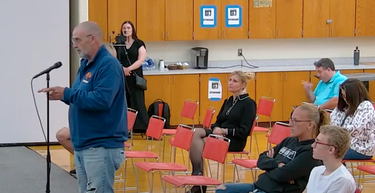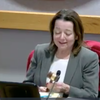Angry, scared parents confront school board on return of student who had threatened harm
GUILDERLAND — Parents expressed outrage at Tuesday’s Guilderland School Board meeting because the district had not informed them that a student who had been charged in February with making a threat of mass harm has now returned to classes.
The Enterprise broke the story on Sept. 5, the first day of school, quoting both the mother of a freshman who had been targeted — her child was one of 20 students and a teacher on a “kill list” — as well as the school superintendent, saying a safety plan is in place but cannot be shared.
On Tuesday, several parents recommended to the board that the child be home-schooled, which the district’s lawyer said the board has no legal right to do. Others expressed fear as well as anger while a 13-year-old student who had been on the “kill list” said he didn’t feel safe despite two adults accompanying the boy during the school day.
As about a dozen district residents listened from the gallery, the Sept. 10 school board meeting started with Superintendent Marie Wiles reading a lengthy statement acknowledging parents’ concerns and saying, “The district has a detailed safety plan with the purpose of protecting both the returning student and all other students and staff.
“We cannot fully share the specific details of the plan, but it does provide in part increased supervision by adults.” She also noted federal laws protecting student privacy.
Over seven months ago, on Thursday, Feb. 1, school administrators called the Guilderland Police after Farnsworth Middle School students brought a “kill list,” posted on social media, to their attention. The eighth-grade boy, now a ninth-grader, who wrote the list was charged with making a threat of mass harm, a misdemeanor.
The next day, Feb. 2, Wiles wrote a notice posted to the district’s website, saying a Farnsworth student “had a list of school community members they intended to harm on a personal electronic device.”
Also on Feb. 2, Farnsworth Principal Michael Laster sent a letter to parents, saying the student “had a kill list on his personal device.”
The student was removed from school.
“The student was transported to a Mental Crisis Center under Mental Hygiene Law 9.41 and was referred to Albany County Probation for the criminal offense,” said the Guilderland Police in a press release on Feb. 3.
After Wiles read her statement on Sept. 10, the school board president, Blanca Gonzalez-Parker read a policy statement on public comment, noting that anyone who wanted to speak to the board on “confidential matters should request an executive session.”
“What if?”
William Critchner, who has a daughter attending the high school, was the first parent to address the board.
“I understand this child has a right to a proper education,” he said of the student who created the list. “I’m all for it. You don’t think it’s fair to the other students to let them know, their parents know, that there is a child in the school?”
The board, which has a policy not to respond in the moment to public comments, was silent.
Critchner also said that the most bothersome part for him was the mental health of the score of kids on the list as well as of the other students at the school.
“My daughter sits near this boy; that’s a problem,” he said.
He went on to say the list-writing boy should be homeschooled. “Homeschooling works; COVID proved that,” said Critchner.
Guilderland, like other schools, is still catching up to return to the learning levels lost during the pandemic shutdown.
Critchner went on to reference the Sept. 4 school shooting in Winder, Georgia, for which a 14-year-old boy has been charged with killing two students and two teachers and wounding others.
“Georgia right there is living proof. The FBI, the greatest police force in the world, couldn’t stop that from happening. And now you’re allowing it to possibly happen here,” said Critchner.
He also said, “My daughter comes to school now every day, going, ‘Dad, what if?’ You’re telling me to tell my daughter she’s protected, she’s OK. I’m telling her to be vigilant. You are not going to tell me you raise my kids better than I do. I promise you, you don’t.”
“This is insane,” he went on, telling the board and the superintendent, “If something happens, this is on you. I pray to God it doesn’t.”
Similarly, another parent, Amber Wagoner said, “If something happens to my kid, I promise you I’m coming for this school.”
Wagoner called having the boy who wrote the list back in school “unacceptable” and said, “There’s other options for schooling.”
Later, her 13-year-old son, Cameron Wagoner, who said he had been on the “kill list,” told the board, “I have no clue why I was put on the list. There was no reason given.”
Similarly, The Enterprise learned from DeAnna Cornelius, the mother of another student on the list, that last school year, the middle-school principal had told her son, “There was no event or discussion or aspect of bullying that occurred that made the individual feel that way.”
Cameron Wagoner told the school board he understood the list-making student had a right to be in school. But, he said, “I feel like I’m not safe at all. Yes, he has two people, two adults who are walking around with him 24/7 ….
“I don’t trust that student. I don’t trust him. I walked by him in the hall one time …. He could just slip away. I don’t trust it. I don’t trust the safety plan at all.”
Rosemary Harrigan, who no longer has children in the school, but lives in Guilderland and has teenage neighbors she said are good friends, told the board, “I’m scared to death for them.”
A retired teacher herself, Harrigan told the board members, “I do not envy you the position that you are in with trying to protect the rights of the young man.”
She also noted their “overwhelming responsibility to the safety of these children.”
Harrigan concluded, “I would like to ask you if each of you believes in your heart that the school safety plan that you have put together will keep all of our children safe from this particular threat. Could anybody answer that for me?”
She was reminded that the board does not answer public comments in the moment.
Bonnie Murray, whose child was on the list, told the board, “We had a restraining order placed and that order has now run out and we have nothing else to do because we can’t get another restraining order. And I don’t even know if it could protect him at this point.”
Her husband, Brian Murray, said he found it “very frustrating” to “say we have all these plans in place, but we can’t get any details on them.”
He said he understood the need to protect the student’s privacy but went on, “There should be something that could be given to us to provide some sort of understanding of what you do have in place.”
Lawyers weigh in
After the last in-person public comment, Gonzalez-Parker called on the district’s lawyer, Jeffrey D. Honeywell, to address the dozen or so residents in the gallery.
“The board knows a lot more about this than any of you because they have to know,” Honeywell said. “The superintendent knows and makes them fully aware: They are under very long-standing federal and state law not to talk about the specifics of a particular student ….
“The final thing is: Don’t believe everything you read in the press; it’s not always accurate.”
The Enterprise, which was the only media that, before the Sept. 10 meeting, had covered the returning student, asked Honeywell what the inaccuracies were so they could be corrected. Over the course of a week, Honeywell did not return a phone call or answer an email from The Enterprise.
At the Sept. 10 meeting, Honeywell also told the citizens in the gallery, “As some of you may or may not know, a resident has an absolute legal right to attend school. You cannot force a student, except in very different circumstances, to go to homeschooling, for example, or in some other situation …. So there are no other options.”
On Sept. 13, the day after The Enterprise published this story about the Sept. 10 meeting online, JP O’Hare, director of communications for the State Education Department, sent an unsolicited copy of correspondence to Wiles from Daniel Morton-Bentley, counsel and deputy commissioner of the State Education Department.
“The State Education Department agrees with Guilderland’s position that student disciplinary records, including the existence or length of a student suspension, are confidential under the Family Educational Rights and Privacy Act,” Morton-Bentley wrote to Wiles, citing a department decision.
He went on, “The Department further agrees that, absent a suspension, all students ‘have a constitutional right to a sound basic education’ in the district where they reside …
“Additionally, while I understand from news reports that certain community members have expressed opposition to a specific student’s return to school, those individuals ‘lack standing to compel [Guilderland] to impose discipline on other students,’ he wrote, again citing a decision.
Morton-Bentley concluded, “The Department supports your efforts to welcome a student who has been suspended back into the school community.”
After the district’s lawyer, Honeywell, spoke at the Sept. 10 meeting and the board was settling into its agenda, those in the gallery left, with some of them expressing their dissatisfaction.
“Shame on you,” said William Critchner. “Shame on you.”



